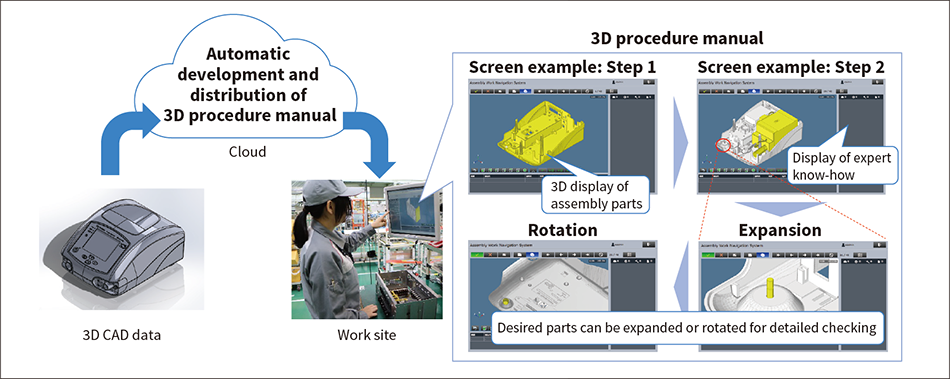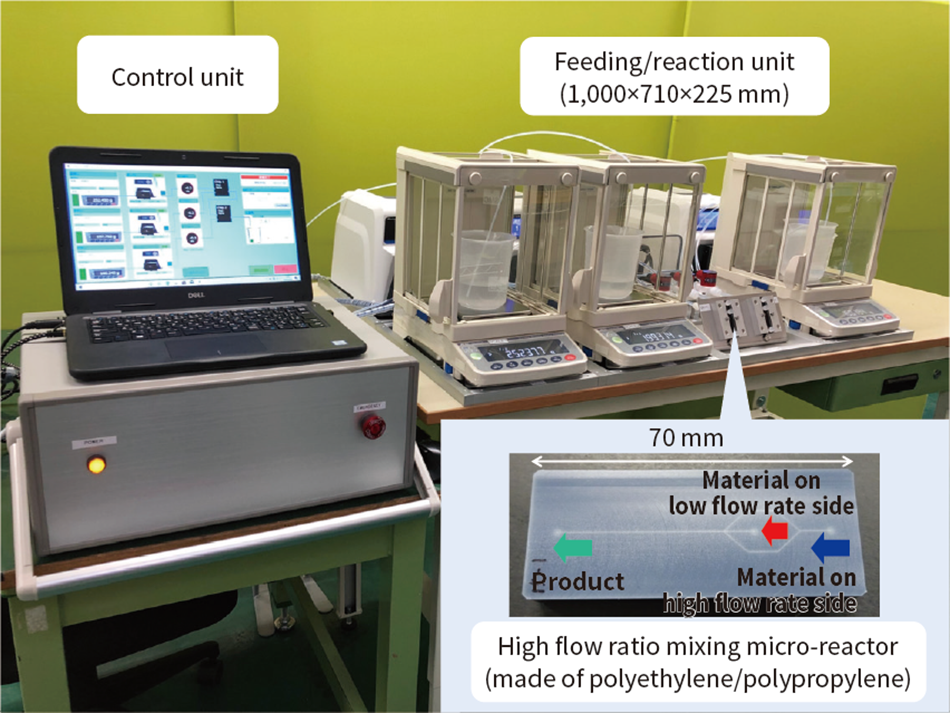Industry & DistributionIndustry
1. Flight Rescheduling Optimization Service to Innovate Front-Line Operation
Highly-skilled, experienced experts are required to correct flight schedules when irregular events such as aircraft maintenance and airport congestion occur. However, the operation is now facing issues such as differences in rescheduling quality and the over-specialization of personnel that occurs when certain employees have been handling particular work for so long that no one else can replace them.
In this service, data such as planned flight schedules and tacit expert know-how are input into Hitachi’s artificial intelligence (AI) and suggestions for the optimal flight rescheduling plan are automatically calculated to reduce the operation time and improve the operation accuracy. This service can provide multiple patterns of rescheduling plans for overall optimization that consider the balance between their impact on passengers and their impact on the operation among multiple plans such as aircraft rotation, crew assignment, and maintenance scheduling. In addition, key performance indicator (KPI) values and alert items at each rescheduling plan are displayed in a report format to help make prompt decisions.
In addition to the above flight rescheduling management, this service can also support production planning that assigns tasks to resources including people and goods (in the aviation industry, flight schedules are assigned to each aircraft and crew as resources). The service is useful in the planning operation where planning corrections occur on a daily basis and such corrections must be made quickly, while retaining the original plan as much as possible.
[1] Overview of the flight rescheduling optimization service
2. IoT platform service for manufacturers
Internet of Things (IoT) platform service for manufacturers is a solution that provides an IoT platform to achieve fast analysis, evaluation and trial that leads to on-site improvements and contributes to creation of new customer values.
As customers cannot feel speedy operational improvements (early value creation), when only provided with the core function to collect and accumulate data from plant sites, recent IoT platform services are pre-bundled with a simple dashboard and analysis function.
However, pre-bundled services cannot always satisfy all of the actual customer operations. Therefore, a mechanism that can build necessary functions in a combination of component groups that are pre-bundled by the customer, just like blocks, is now required as an interface for data use.
Hitachi’s IoT platform service for manufacturers offers an interface that allows customers to step up from pre-bundled data use service and its application to various customers is now under consideration.
3. Collaborative Design Solutions to Respond to the New Normal
Due to the spread of COVID-19, the use of remote work is also required at design workplaces. However, in the Genchi Genbutsu culture, where people believe that facts and data should be collected at the actual site of the work or problem, remote work is not widely practiced in reality. In response, Hitachi provides designers with Hitachi Digital Supply Chain/Design to implement remote work. This solution supports reforms in terms of how efficiently to develop conventional designs as required by designs in the new normal and from the perspective of improving the operational efficiency and design quality by means of IT.
More specifically, this solution uses an advanced remote workstation, which achieves location-free designs, operational navigation, which enables seamless work progress across different sites and departments, and accumulated design knowledge to offer an awareness-supported computer-aided design (CAD) environment, which prevents the omission of design requirements. The solution supports a design workstyle reform in the new normal era.
4. Next-generation maintenance solution using ConSite
In October 2020, Hitachi started to provide industrial machinery manufacturers with ConSite-based operation improvement consulting and data reporting functions. ConSite is a remote monitoring solution for construction machinery, which is provided by Hitachi Construction Machinery Co., Ltd., with a large number of contracts signed for it in the past (a total of 143,000 units in 113 countries/regions*).
The customer can choose either (1) sole introduction of the reporting function in a short time or (2) consultation-combined introduction to support up to effect creation and stabilization after the introduction. The solution also supports the introduction of on-premises or cloud service according to the customer’s system environment.
This solution not only improves the operating rate of the equipment used by the end user, but also improves the quality of remote maintenance operation in response to the times during and after the COVID-19 pandemic and strengthens the capability of maintenance personnel to make suggestions to help industrial machinery manufacturers increase sales and profits of their after-sale services. At the same time, the solution also addresses social issues such as the complication of failure analysis due to the advancement of product technologies and shortages of engineers.
Hitachi regards this solution as Lumada’s next-generation maintenance solution and further promotes the generation of social values, environmental values and economic values by providing the solution.
- *
- As of the end of March 2020.
[4] Concept of the ConSite-based next-generation maintenance solution and an image of its introduction
5. On-Site Fault Diagnosis Support Service
Hitachi’s fault diagnosis support service for truck maintenance sites displays information about faulty vehicle conditions, parts that should be repaired and repair details on the mechanic’s tablet or other terminal.
The fault diagnosis support uses machine learning technology for modelling, based on the vehicle operation information (numerical data) and the fault condition and past repair information (text) obtained by numerous sensors, and presents repair details according to the past faulty conditions. In introduction cases of use of this service in North America, the accuracy of repair details has increased to 80% or more, resulting in shortened fault detection times and reduced repair repetition rates. Hitachi is also committed to improved productivity of mechanics, fault predictive detection and other solutions to improve the efficiency of the overall maintenance operation.
As the demand for freight transportation continues to expand, the truck industry is facing issues such as increasingly severe shortage of mechanics and the complication of fault diagnosis due to the greater sophistication of vehicles. Hitachi is going to use these solutions to address the issues faced by the freight transportation industry.
6. Product Quality Real-Time Monitoring Solution for Manufacturing Sites
To control the final quality of polymer products at their manufacturing sites, it is important to know the condition of each product in the middle of its reaction process. In order to know the condition, reactor sampling and measurement using multiple analyzers are performed repeatedly and this is one of the factors that increase their lead time in the manufacturing process. As part of the smartification for manufacturing process of polymer products, Hitachi is developing a real-time monitoring system that monitors product quality in real time and feeds back the obtained results into the manufacturing process.
This system uses spectroscopic analysis technology as its measurement method to enable in-line measurement of multiple qualities with a single analyzer and a real-time check of the reaction condition. At present, the verification of the quality measurement accuracy of the system is completed. Hitachi is going to identify issues for in-line transformation of the system and continue to verify its systematization. In the future, Hitachi will strive to develop an optimization solution for manufacturing processes that will use AI to analyze the quality data measured in real time as well as other sensing data and feedback the results into the sequential process control.
[6] Product quality real-time monitoring solution for manufacturing sites
7. Productivity and Quality Improvement Solution for Assembly and Machining Workplaces Using 4M Data Analysis
Hitachi is currently providing services that collect, record and use (manage) human, machine, material, method (4M) data related to production resources at manufacturing sites integrally and analyze factors of issues about customers’ production losses, quality and maintenance as well as their improvement measures.
One of such services is 4M loss analysis service, which can transform into models the analytical know-how in expert viewpoints and loss factors for production control from the perspective of 4M data. Functions and values that allow customers to understand 4M data cross-sectionally in a time series can be provided to help solve issues arising from customers’ manufacturing sites. Hitachi also makes mechanisms of methods for obtaining 4M data more versatile to help users achieve IoT transformation. Furthermore, the 4M data obtained from loss factor analysis can be accumulated and used not only to identify loss factors that stop improvement of productivity, but also to identify poor quality and other losses that occur at manufacturing sites.
With the solution using 4M data as the starting point, Hitachi is going to promote IoT transformation and digital transformation (DX) of manufacturing sites of many customers.
8. Autonomous Picking Robot to Replace Logistics Warehouse Operation
Hitachi’s Autonomous Picking Robot System is a solution that uses an industrial robot to replace the picking operation in a logistics warehouse, which used to rely on manual labor, without the need for teaching. The operation at a manufacturing site handles a large number of product types. As their quantities change according to daily order quantities, and the position and direction of each product placed in its storage case are not always the same, either, the flexibility to perform the operation under different conditions each time is required.
Hitachi’s Autonomous Picking Robot System, which is equipped with autonomous control software, uses an object recognition function to recognize the shape and position of each product in the same manner as humans look at a product, reach out their hands, grab and work with the product. This system also uses a movement plan generation function to plan robot arm movements and uses a control function to move the arm and perform picking operation.
Since the system can use the latest algorithms through software updates at all times, it enables the addition of new products and the start of new tasks with very little down time, while using the existing facilities.
Hitachi continues to contribute to the sophistication of logistic centers overall through the development of autonomous robots that can be applied to logistic warehouses.
[8] Example of introduction of Autonomous Picking Robot System delivered to Hitachi Transport System, Ltd.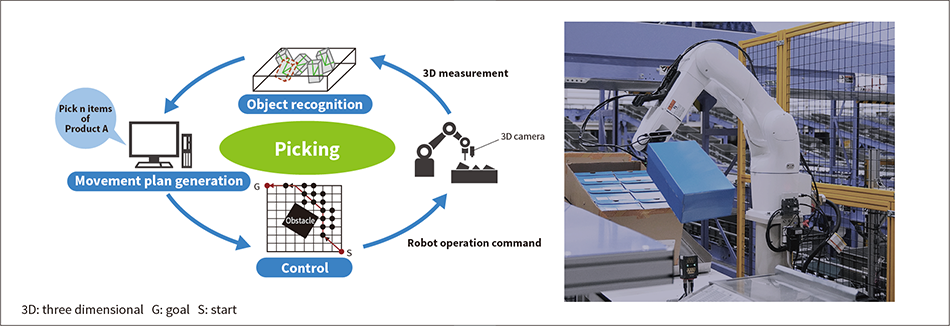
9. Release of an Artificial Ventilators Assembly Procedure Manual Based on Assembly Work Navigation System
Hitachi has released a 3D artificial ventilator assembly procedure manual, using an assembly work navigation system, to support manufacturing of artificial ventilators that are essential for fighting against the novel coronavirus.
The 3D procedure manual is based on the design specifications (3D CAD data) of an artificial ventilator released by Medtronic PLC, a global healthcare company, and provided as cloud service.
The assembly work navigation system calculates the assembly order of an artificial ventilator according to its design specifications, using original algorithms, and develops its procedure manual automatically. The system also displays the developed assembly procedure on one screen for each task by part to be mounted, according to the assembly order. As the operator performs each task, while looking at the displayed screen, they can save the time and effort required to work out the assembly order from the production drawing by themselves in the conventional manner. In addition to the procedure, the system also displays expert know-how on the screen. Therefore, unexperienced operators can also understand and perform tasks intuitively.
The assembly work navigation system can also be applied to products other than artificial ventilators and Hitachi is planning to commercialize assembly procedure manual development service.
10. Active Control of Induction Motor Torque Characteristics for Steel Plants
Active control of induction motor torque characteristics has been added to Hitachi’s cell concept motor drive system for steel plants. This new function can control the field magnet characteristic of an induction motor actively to change the weighting of the motor-generated torque with respect to the torque current. In the conventional method, for example, when low-tension rolling that was not assumed during facility planning is required due to the diverse needs of the steel market, the torque current is controlled to a smaller value to generate low torque. In this method, however, stable rolling cannot be achieved sometimes, because the dominant control amount is reduced and the control accuracy deteriorates. The new function, on the other hand, can generate low torque without changing the size of the torque current and reduce the deterioration of the control accuracy that interferes with stable rolling.
The cell concept motor drive system has been helping customers reduce the space cost in facility management, achieve long operating life and reduce environmental load by downsizing, retrofitting and enhanced efficiency. The new function is expected to further contribute to meeting social needs and improving asset values. Hitachi plans to continue to develop better motor drive systems that can help customers solve their management issues.
[10] Active control of induction motor torque characteristics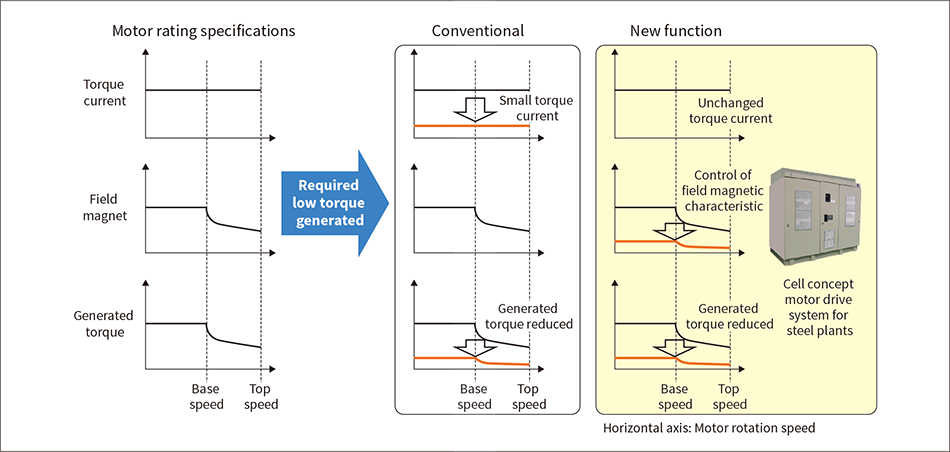
11. Safety and Quality Improvement Solution
In recent years, work-related deaths have been on the decline, but workers with casualties who are absent from work for four days or longer are increasing every year. At workplaces, personnel shortage has been a serious issue and it is also difficult to work overtime or on holidays due to the workstyle reform. However, workers are becoming more exhausted because of the pressure to improve their productivity and the risk of deterioration of product and work quality is increasing. To address these issues occurring at production sites, Hitachi has started providing a safety and quality improvement solution.
This solution combines products supporting safety and quality, AI-based analysis and solutions leveraging failure analysis to provide consistent support, ranging from accident report creation and management, accident analysis to preventive measure development, skill transfer and training stabilization.
The solution not only manages and uses accident data in an integrated manner to prevent accidents from occurring or recurring, but also coordinates the data with systems to display the risk of accident occurrences during work planning as well as related training contents and work procedures to help prevent accidents.
Through this solution, Hitachi continues to provide one-stop support in order to achieve customers’ zero-accident target.
(Hitachi Industry & Control Solutions, Ltd.)
[11] PDCA process using work error and accident cause analysis, based on the safety and quality improvement solution
12. AI-Based Human Posture and Movement Recognition Solution
In recent years, use of camera images in workplace management has been promoted for the purpose of:
- Understanding variations and individual differences in working hours that lead to production efficiency
- Understanding workers’ procedure implementation results and actual working hours that affect quality
- Understanding workers’ posture and behaviors that lead to work-related accidents
In some cases, however, the above situations are analyzed through visual inspection or sufficient data is not used. Hitachi’s AI-based human posture and movement recognition solution supports the labor-saving and on-site visualization of checking of these work conditions.
This solution uses an original AI-based analysis function to analyze human posture and movements from images taken with a camera, convert them into data and visualize them in graphs or other forms. Its basic functions are provided as part of platform software.
The tool (graphical user interface: GUI) of the platform software is used to execute analysis and allow users to use the obtained analysis results at their work. In addition, more effective work and safety management can be achieved, if a programming interface is used to develop applications provided with functions to monitor work conditions, accumulate analysis results and video images, display and look back at analysis results.
(Hitachi Industry & Control Solutions, Ltd.)
[12] Conceptual image of the human posture and movement recognition solution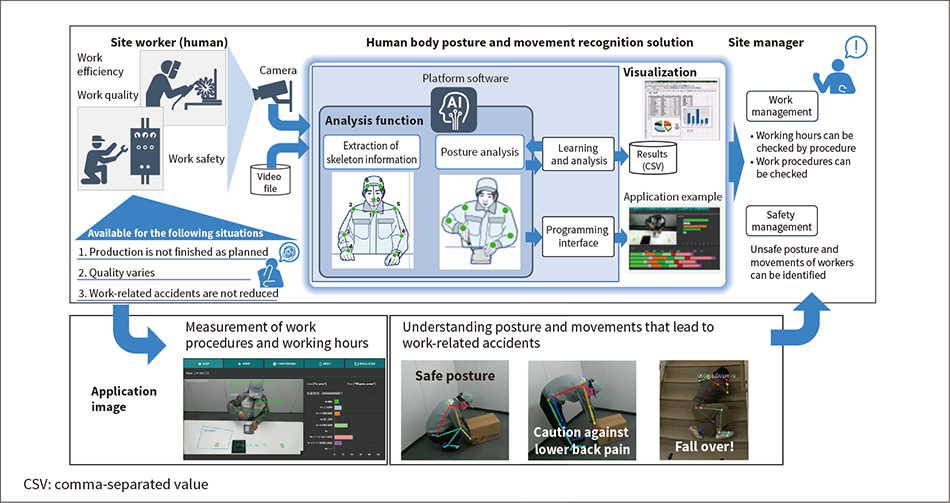
13. Manufacturing of Pharmaceuticals by Using a High Flow Ratio Mixing Single-Use Micro-Reactor
Hitachi has developed a resin micro-reactor that can mix two kinds of raw materials at a high flow ratio. The micro-reactor is a continuous-flow chemical reaction device that can mix materials in a very small channel quickly, control the reaction temperature precisely and improve the manufacturing efficiency of pharmaceuticals dramatically. The sheath flow channel that holds one material with the other enables its application to mixing in a wide range of flow ratios. As it is made of high corrosion resistant polyethylene or polypropylene, single-use (disposable) application, which is required in manufacturing of biopharmaceuticals, has also been achieved.
In addition, Hitachi has also developed a single-use micro-reactor system for laboratories, which is equipped with two units of this micro-reactor. With easy plug-and-play setup as well as pump control and weight/pressure monitoring on the control screen, it aims to achieve the operability equivalent to the conventional batch method.
Hitachi is going to build systems equipped with micro-reactors for which scale-up verification has already been performed and provide pharmaceutical manufacturing plants that use such systems as the core.
(Hitachi Plant Services Co., Ltd.)





